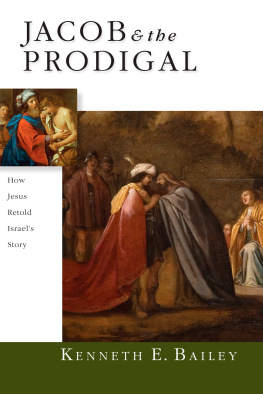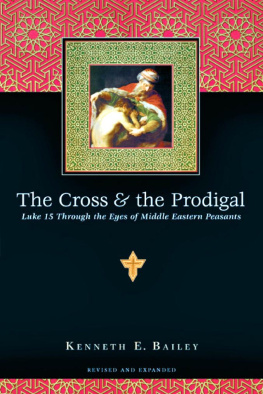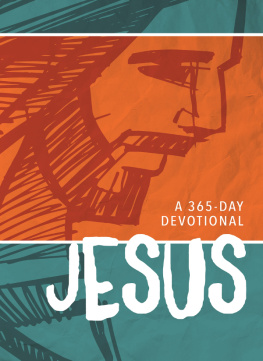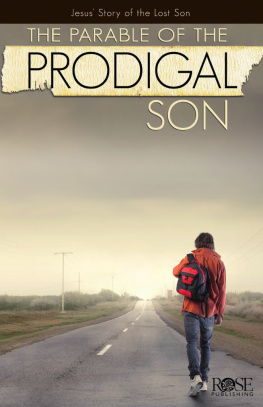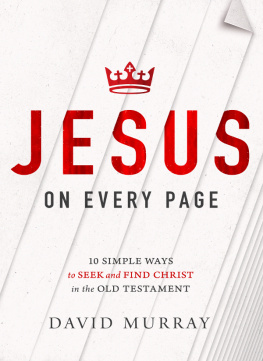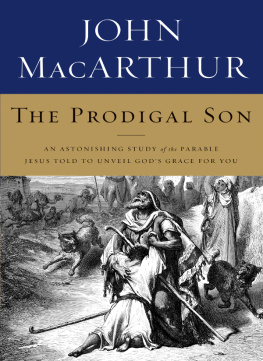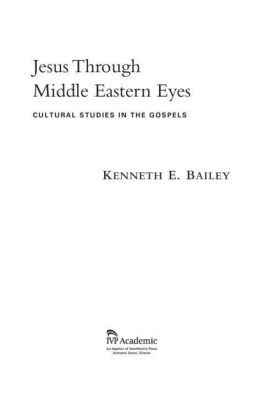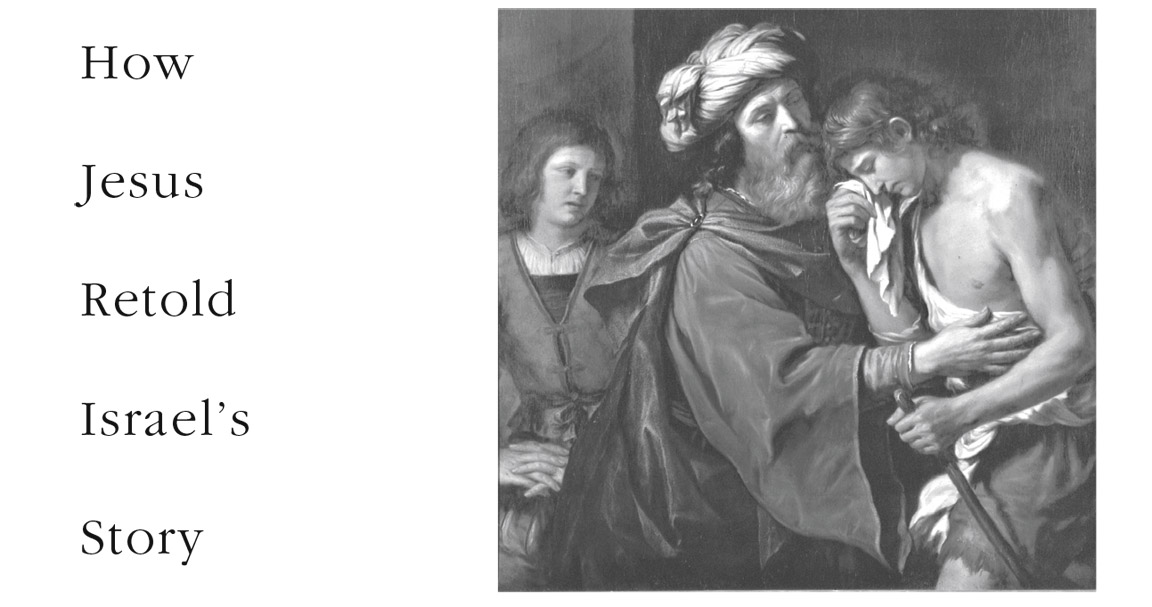Sommaire
Pagination de l'dition papier
Guide
JACOB & the
PRODIGAL
KENNETH E. BAILEY
InterVarsity Press
P.O. Box 1400, Downers Grove, IL 60515-1426
World Wide Web: www.ivpress.com
E-mail:
2003 by Kenneth E. Bailey
All rights reserved. No part of this book may be reproduced in any form without written permission from InterVarsity Press.
InterVarsity Press is the book-publishing division of InterVarsity Christian Fellowship/USA, a movement of students and faculty active on campus at hundreds of universities, colleges and schools of nursing in the United States of America, and a member movement of the International Fellowship of Evangelical Students. For information about local and regional activities, write Public Relations Dept., InterVarsity Christian Fellowship/USA, 6400 Schroeder Rd., P.O. Box 7895, Madison, WI 53707-7895, or visit the IVCF website at .
Scripture quotations, unless otherwise noted, are from the Revised Standard Version of the Bible, copyright 1946, 1952, 1971 by the Division of Christian Education of the National Council of the Churches of Christ in the U.S.A., and are used by permission.
Cover design: Kathleen Lay Burrows
Cover and interior images: The Meeting of Esau and Jacob: The Jewish Museum, NY/Art Resource, NY;
Return of the Prodigal Son: Alinaii/Art Resource, NY
ISBN 978-0-8308-6885-8 (digital)
ISBN 978-0-8308-2727-5 (print)
This digital document has been produced by Nord Compo.
To
SARA JAN BAILEY
in gratitude for her living faith
her courage in adversity
her compassion for all who suffer
her tenderness toward every living creature
and her deep love for her family and friends
FIGURES
PREFACE
I nasmuch as many have undertaken to interpret the parables, it seemed good to me also, having followed all things closely for some time past, to write an orderly account (Lk 1:1, 3) of what I have learned about Luke 15 and of how the parable of the prodigal son is a new story patterned after the saga of Jacob.
For sixty years, from 1935 to 1995, my home was in the Middle East, first as a child and then as an adult. As an adult, teaching in Arabic Christian circles, reading Arabic and Syriac Christian literature from the early centuries, and trying to glean as much as possible from the extensive writings of the early rabbis, it has been my privilege to study the New Testament in the light of the cultural world of the Middle East. It is out of that background that I approach this topic.
For hundreds of years the Latin tradition has called this parable Evangelium in Evangelio (the gospel within the gospel), and so it is. But to discover its depths one must turn a number of corners in the mind while, at the same time, wrestling with a series of critical problems that the text presents even to a casual reader.
Jesus appears in the Gospels as a theologian who begins with a mastery of the tradition and then reshapes it by offering a new vision centered on his own person. This book will attempt to trace the movement of Jesus mind along one critical stage of that vision. It is my intention to examine carefully the way in which Jesus takes the great saga of Jacob and reflects it in a new story composed with himself at its center. Jesus walks on stage not as a different Jacob but, rather, as a transformed figure of the father (Isaac). Reaching this conclusion has required some patient digging.
Biblical exegesis is much like Middle Eastern archeology. The archeologist often returns, season after season, to the same tell, each year penetrating a deeper level of the ancient site in the hope of making a new and significant discovery. There is always the tantalizing possibility that the next dig may uncover a mosaic floor, a stone inscription or even a library.
For decades, the Until recently, I was confident that I had considered at least all the major interpretive options available. Then, after extended intense focus on this tell, I almost tripped over an ancient inscribed mosaic floor whose existence I had completely missed. For seven years, the British archeologist Howard Carter deliberately searched for the tomb of Tutankhamen and finally found it. I cannot take credit for such an intentional search because I chanced onto a treasure without even looking for it.
A gnawing hint of a connection between Luke 15 and the Jacob saga has lingered at the back of my mind for decades. This possible parallel was reawakened in my consciousness by a brief footnote in N. T. Wrights book Jesus and the Victory of God.
But, to my knowledge, a full comparison between the prodigal and Jacob has not been pursued. In my personal study, a list of fifty-one points of comparison and contrast have gradually emerged. Because the fifty-one are interwoven, any discussion of them inevitably produces some overlapping. Furthermore, the full significance of these parallels cannot be captured in a single brief volume. Instead, I intend here to display the unearthed artifacts (as it were), with a few preliminary reflections on what they may mean.
Some of these parallels are heavily freighted with theological significance. Others appear to function only as threads that help bind the two stories together. Multiple examples of each type appear below. It will be argued that in Luke 15:4-32, Jesus of Nazareth addresses the scribes and Pharisees and through them speaks to the entire nation. He deliberately creates a new story patterned after the Jacob story and offers his people a revised identity story with himself at its center. As Wright says, Most historical characters worth studying are so because they held mindsets that formed significant variations on the parent worldview. These variations on the parent worldview are the subject of this monograph.
Another way to look at this task is to view the parable of the prodigal son as a story with three settings like three zoom-lens photographs of a single scene. Imagine being shown a photograph of a happy child on a swing. The picture has its own integrity and is a joy to behold. Then the photographer places a second picture beside the first; the second is the same scene but has been taken with a wider lens. Now it is possible to see the mother pushing the child on the swing and observe that the swing is suspended from the branch of a cherry tree in full bloom. The smile on the childs face takes on new meaning, and the larger picture provides the viewer with additional delights. Finally, the photographer presents a third picture, which is still of the same scene. Only this time the shot is even wider, and it is evident that the cherry tree with its swing is growing in a zoo and that the child is looking at a baby elephant being cuddled by its mother. Once again the yet larger scene adds new and important meaning to the other two.
In like manner, the parable of the prodigal son can be studied on its own. Such a close-up is certainly valid. A wider lens shows the parable of the prodigal as part of the three lost-and-found stories in Luke 15. This is like looking at the child on the swing with the mother and the cherry tree in view. The third shot depicts how the parable of the compassionate father and the two lost sons, as I prefer to call it, is a reshaping of the saga of Jacob. This is akin to the third picture that shows the child on the swing in the zoo looking at the elephants. Examining the third picture is the major task of this book. It will be necessary to reflect briefly on the close-ups before getting to the widest lens, and perhaps a good starting place for the whole endeavor is to note a few unsuspected problems that the entire chapter presents.

